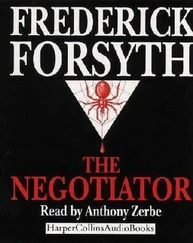The message was taken by the permanent listening watch inside the Office. It was decrypted by the officer of the watch, who passed it to Benny, still at his desk in the same time zone as Kismayo. He composed a short instruction, which was encoded and beamed to a boat masquerading as a Salalah-based fisherman twenty miles off the Somali shore.
* * *
The rigid inflatable left the side of the fisherman a few minutes later and sped toward the shore. It contained seven commandos and a captain in command. Only when the sand dunes of the coast came into sight in the moonlight did the engine level decrease to a slow growl, in case of listening ears even on this desolate stretch of sand.
As the nose ground into the sand, the captain and six men leapt ashore and ran for the road. The spot, they already knew; it was where a dry wadi ran under a concrete bridge and a clump of casuarinas grew. One of the men jogged three hundred yards up the road toward Kismayo, found a spot in the sedge by the roadside, lay down and fixed his powerful night vision goggles on the road south. He had been told exactly what vehicle to look for and even its plate number. Behind him, the ambush party also lay in the cover roadside and waited.
The captain lay with the communicator in his hand, where he could not miss the pulsing red light when it came. Four vehicles went past, but not the one they wanted.
Then it came. In the green half-light of the night vision goggles, the commando down the road could not mistake it. Its dirty off-white original color was irrelevant in the all-green glow of the NVGs. But the battered grille was there, along with the twisted roll bar that had clearly not done its job. And the front number plate was the one he was looking for. He pressed the send button on his pulser.
Behind him the captain saw the red glow in his hand and hissed, “Kadima,” to his men. They came out of the ground, from both sides of the road, holding the broad red-and-white tape between them. In the darkness, it looked like a horizontal pole. The captain stood in front of it, shining a shaded torch at the ground, his other hand raised.
They were not dressed in camouflage but in long white robes and Somali headdresses. They all carried Kalashnikovs. No Somali would dare drive through a roadblock manned by the religious mutawa . The engine of the oncoming pickup truck coughed as the driver changed down a gear, then another.
* * *
The pirates had left two of their number to keep the Taiwanese skipper and his first-mate prisoner. The other eight had boarded the Malmö . One spoke a smattering of English. He came from the Garacad pirates’ nest, and this was his third capture. He knew the routine. Capt. Eklund did not, despite his briefing from a Swedish naval officer back in Gothenburg.
He knew he had had time to press the send button of the perpetual Mayday signal from his cabin. He knew it would be transmitting from his mast top, alerting a listening world that he was captured.
The pirate leader, who was twenty-four and called Jimali, knew it, too, and did not care. Let the infidel navies come; it was too late now. They would never attack and trigger a bloodbath. He knew of the kuffar obsession with human life and despised it. A good Somali feared neither pain nor death.
The five Europeans and ten Filipinos were gathered on deck. Capt. Eklund was told that if any more were hiding, one of the officers would be thrown into the sea.
“There are no more,” said the captain. “What do you want?”
Jimali gestured to his men.
“Food. No pig,” he said. Capt. Eklund told the Filipino cook to go to his galley and prepare food. One of the pirates went with him.
“You. Come.” Jimali beckoned the captain, and they went to the bridge. “You steer Garacad, you live.”
The captain consulted his maps, presumed the Somali coast and found the village a hundred miles south of Eyl, another pirate concentration. He worked out an approximate heading and turned the helm.
A French frigate from L’indien was the first to find them, just after dawn. It took up station several cables to port and reduced speed to stay in formation. The French captain did not intend to use his marines to board the Malmö , and Jimali knew it. He stared across the water from the bridge wing, almost challenging the infidels to have a go.
Far away from the seemingly harmless maritime spectacle of a French frigate escorting a Swedish freighter with a Taiwanese trawler far behind, a whirlwind of electronic communication was taking place.
The Malmö ’s automatic identification system had been picked up instantly. It was monitored by the British Maritime Trade Operations out of Dubai and the American MARLO, the maritime liaison out of Bahrain. A score of NATO and EU warships were alerted to her problem, but, as Jimali knew, none would attack.
The Andersson Line maintained a night-and-day operations room in Stockholm, which was immediately advised. The shipping HQ called the Malmö . Jimali indicated that Capt. Eklund could take the call but put it on the bridge speaker and converse only in English. Even before he spoke, Stockholm knew he was in the presence of armed Somalis and every word should be guarded.
Captain Eklund confirmed that the Malmö had been taken in the night. His men were all safe and were being well treated. There were no injuries. They were steaming under orders for the coast of Somalia.
The shipowner, Harry Andersson, was roused over breakfast in his palatial home in a walled park in Östermalm, Stockholm. He finished dressing while his car was brought to the door, then drove straight to his operations room. The fleet controller of the night shift had stayed on. He explained everything that the emergency services and Capt. Eklund had been able to tell him.
Mr. Andersson had become a very successful, and thus rich, man because he had two very useful talents, among others. One was to assimilate a situation with extreme speed and, having done so, create a plan of action based on realities, not fantasies, and then go for it.
He stood, plunged in thought, in the middle of his operations room. No one dared disturb him. His ship had been taken by pirates, his first ever. Armed assault at sea would trigger a massacre and was simply not going to be attempted. The Malmö would therefore make the Somali coast and be anchored there. His first duty was to his fifteen employees, then to recover ship and cargo if possible. And then there was the question of his son.
“Bring my car to the door,” he said. “Call Björn, wherever he is, and tell him to get the plane ready for immediate takeoff. Flight plan for Northolt, London. Book me a suite at the Connaught. Hannah, you have your passport with you? Then come with me.”
Minutes later, in the back of his Bentley, his PA Hannah beside him, speeding to Bromma airport, he used his mobile phone to plan the immediate future.
It was a matter for the insurers now. He insured through a specialist syndicate of underwriters at Lloyd’s. They would have the whip hand because the money at risk was theirs. That was what he paid them an annual fortune for.
Before he was airborne, he had learned his underwriters’ negotiator of choice — and they definitely had been down this road before — was a firm called Chauncey Reynolds, which had a track record of negotiated recoveries. He knew he would be in London long before his ship would reach the Somali shore. Before his Learjet reached the Swedish coast, he had an appointment with the lawyers at six p.m. Well, they would damn well have to work late.
While he was on the glide path of Northolt touchdown, Chauncey Reynolds was preparing. They were trying the Surrey home of their negotiator of choice, the half-retired ace of his strange profession. His wife fetched him from among the beehives in the garden.
Читать дальше










